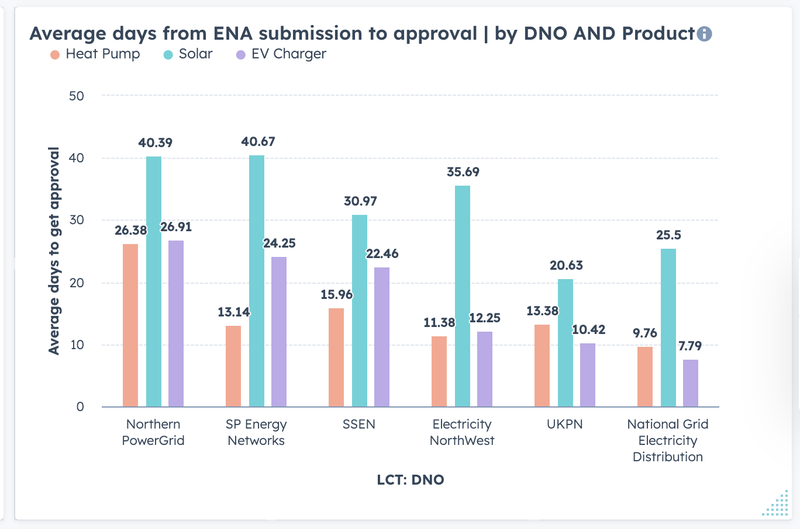The background
Thousands of customers around the UK are choosing electric vehicles, solar panels and heat pumps to help reduce energy costs and carbon emissions. Yet customers can sometimes face significant delays before an installation at their home is possible. What’s more, the amount of time they have to wait will vary depending on where they live.
This postcode lottery of delays is caused by the complex and inconsistent processes used by the Distribution Network Operators (DNOS), who currently have to approve all installations. As customer demand for these technologies begins to grow exponentially, we want to work with DNOs, policy makers and wider industry to tackle this issue and help provide customers with the best experience possible.
To help achieve this, we’re sharing our data on DNO performance on install approval delays…
| 🏆 | Distribution Network Operator | Average days to approve |
|---|---|---|
| 🥇 | National Grid Electricity Distribution | 13 |
| 🥈 | UK Power Networks | 14 |
| 🥉 | Electricity North West | 18 |
| 4 | Scottish & Southern Energy Networks | 24 |
| 5 | Scottish Power Energy Networks | 25 |
| 6 | Northern Powergrid | 31 |
Our data shows that customers in the worst performing DNO are having to wait on average over 1 month for their approval to install low carbon tech in their home. These delays don’t apply to fossil fueled options – we think this needs to change. This is an important challenge, but there are plenty of solutions.
A look at the data


Our data shows for Octopus customers:
Those living in NGED and UKPN areas have won the postcode lottery. Both DNOs average a 14 day approval across LCTs, compared to 31 days in NPGs area.
The slowest experience a customer could face is likely to be for installing solar in NPG or SPENs areas, who both have an average of 40 days to approve an installation.
Priority actions for DNOs
We’ve identified 5 priorities for DNOs to speed up approvals for low carbon tech (LCT):
Maximise the use of auto-approvals
DNOs can and do immediately approve LCT connections if they meet certain criteria. To help installers, DNOs should immediately publish these criteria on which can connect and where without works required.
Set a clear deadline for approval timings
Approvals currently have no deadline attached. This needs to change, with clear minimum standards to help give customers more confidence in the process. Equally, all technologies require a simple, streamlined process for submitting applications through ENA’s Direct Connect.
Update engineering assumptions
There are several ways that DNOs can change their methodologies for faster approvals, such as:
- Using actual data to set demand thresholds: Today many DNOs use theoretical maximum demand assumptions that don’t reflect reality and these can be updated with real customer data.
- Increase solar ‘G99’ thresholds: DNOs will automatically approve solar installs below 3.68kW, but this threshold can be increased. UKPN already has a 5kW limit and has sector leading performance on solar installs.
- Review statutory voltage limits: this will require change across the sector but would enable more LCTs to be installed
Enable flexible solutions to mitigate risk
Some DNOs already promote load limiting devices or flexible technologies to approve LCTs more quickly. These creative solutions should be maximised and best practice followed across the sector.
Allow third parties to carry out essential works
Collaborating with and allowing third parties to carry out works, such fuse upgrades, can cut installation times by minimising the number of house visits required. UKPN and NGED already allow Octopus to carry out fuse upgrades for customers, significantly reducing install delays.







